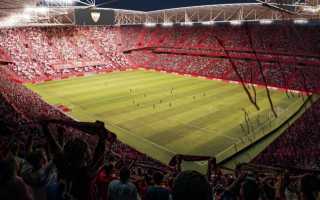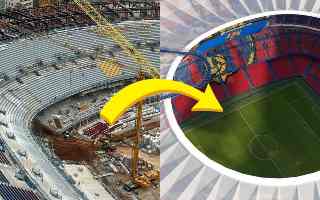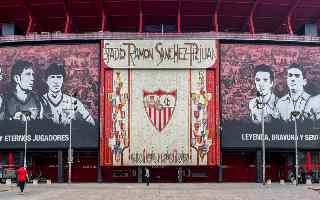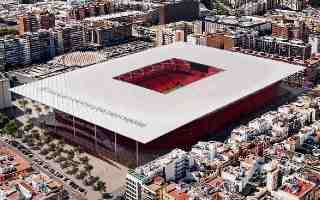Estadio Ramón Sánchez-Pizjuán (La Bombonera de Nervión)
| Capacity | 43 751 |
|---|---|
| Country | Spain |
| City | Seville |
| Clubs | Sevilla FC |
| Other names | La Bombonera, La Bombonera de Nervión |
| Inauguration | 07/09/1958 (Sevilla FC – Real Jaén 3–3) |
| Construction | 1956–1958 |
| Renovations | 1975, 1982, 2015 |
| Design | Manuel Muñoz Monasterio |
| Address | Calle Sevilla Fútbol Club, s/n, 41005 Sevilla |
Advertisement
Estadio Ramón Sánchez-Pizjuán – stadium description
What is the Estadio Ramón Sánchez-Pizjuán like in a nutshell?
Sevilla FC's stadium was inaugurated in 1958, although the missing upper sections of the stands behind the goals weren't added until 1975. Prior to the 1982 World Cup, the facility received improvements including a roof over the main stand and unique mosaic on the facade. With the installation of seats in all stands in the 1990s, its capacity decreased to more than 40,000 spectators.
A series of renovations initiated in 2015 and continued over the next few years improved the venue's aesthetics, including the addition of a white façade and repainting of the seats as well as concrete elements. A club museum has also been created. However, there are already plans to build a brand new stadium to replace it.
The stadium is located in the Nervión district, near the center of Sevilla. The facility belongs to Sevilla FC, one of the oldest clubs in Spain, which frequently changed locations in its early years and only settled for longer in Nervión.
The facility is named after Ramón Sánchez-Pizjuán, the club's longtime president, who was largely behind the creation of the stadium, but did not live to see it open himself (he died shortly before construction officially began).
In addition to Sevilla FC matches, the stadium has had the opportunity to host other events, such as two 1982 World Cup matches, including the thrilling Germany-France semifinal, which ended with the first penalty shoot-out in World Cup history; the 1986 European Cup final, in which Steaua Bucharest goalkeeper Helmuth Duckadam defended four penalty kicks; and matches of the Spanish national team, which has never lost here.
How did the Estadio Ramón Sánchez-Pizjuán come to be?
Sevilla FC, one of the oldest clubs in Spain, played its matches at various venues in Seville in the early years. From 1918, the team played at Campo de la Reina Victoria. In 1928, however, the owners of the site sold it to the organizers of the Ibero-American Exhibition, and the club had to find another venue.
A new plot of land was leased in the Nervión district, and another stadium was built there, inaugurated on October 7, 1928. In the 1930s, during the presidency of Ramón Sánchez-Pizjuán, the club bought the plot of land with the stadium, as well as the land adjacent to the east, planned for the construction of a new, larger facility in the future. The club paid the owner, Pablo Armero, 429,000 pesetas to purchase the land.
The idea of building a new stadium right next to the existing facility began to be realized in the 1950s, and one of the main promoters of the investment was Ramón Sánchez-Pizjuán, who had again served as president of Sevilla FC since 1948. In January 1954, the club announced a competition for the architectural concept of the new arena. The competition was won by Manuel Muñoz Monasterio, who had previously worked on the design of Real Madrid's new stadium, among other projects.
When was the Estadio Ramón Sánchez-Pizjuán built?
Ramón Sánchez-Pizjuán died on October 28, 1956, having not lived to see the new stadium built. The groundbreaking ceremony took place just over a month after his death, on December 2, 1956. In recognition of Ramón Sánchez-Pizjuán's contribution, the new stadium was decided to be named after him. Due to the poor ground, 800 concrete piles had to be driven into the ground before the actual construction could begin.
When was the Estadio Ramón Sánchez-Pizjuán inaugurated?
The new facility was inaugurated on September 7, 1958 with a friendly match against Real Jaén (3–3). On September 21, 1958, the first official match was played at the stadium, which was a league game against derby rival Real Betis (2–4).
When was the Estadio Ramón Sánchez-Pizjuán fully completed?
At the time of its construction, the stadium was not yet fully completed: behind the goals, the upper level of the stands was missing, and the main stand was partially out of use. Soon after the new stadium opened, demolition of its predecessor (Estadio de Nervión) began. Later, a parking lot was located in its place, and the Nervión Plaza shopping center opened there on March 18, 1998.
On May 7, 1959, on the occasion of a friendly match against Bayern Munich (1–5), artificial lighting was inaugurated at the stadium. The missing second tiers of stands behind the goals were not ready until 1975: the south stand (Gol Sur) was fully commissioned on September 7, 1975, and the north stand (Gol Norte) on October 26, 1975. The stadium then reached a capacity of more than 70,000 spectators.
What upgrades did Estadio Ramón Sánchez-Pizjuán undergo?
Before the 1982 World Cup, a roof was built over the main stand, and the stand's facade was decorated with a distinctive mosaic by Santiago del Campo. New lighting and additional boxes were also installed, and the stadium's capacity was reduced slightly.
In the 1990s, the stands were fully equipped with plastic seats, significantly reducing the capacity of the facility, which can now hold more than 40,000 people. On December 18, 2005, another mosaic was unveiled on the façade of the south stand by Moroccan artist Ahmed Ben Yessef.
In 2015, the stands were refreshed, new video screens were installed and the seats were repainted red. In 2016-2017, thestands on the north, east and south sides received a façade composed of white panels. A new mosaic was created on the south façade, different from the one made in 2005. The façade of the main stand, on the sides of the original 1982 mosaic, was decorated with banners.
In the next few years, more renovations were carried out. On September 7, 2018, the 60th anniversary of the facility's inauguration, a club museum was opened at the stadium.
What will be the future of Estadio Ramón Sánchez-Pizjuán?
A major redevelopment of the stadium has been attempted since the early 2000s. In 2006, a competition was held for an architectural concept to modernize the facility, including the roofing of the stands. Several interesting designs were presented, and the vision by Estudio Lamela and CRV arquitectos won. However, due to insufficient funding, the concept was not implemented.
Instead of a redevelopment, only a series of upgrades, initiated in 2015, were carried out. However, when a huge investment opportunity arose at the end of 2021, due to an agreement between LaLiga and the CVC Capital Partners fund, steps were again taken to carry it out. The design for the redevelopment was created by the renowned IDOM studio, and the concept was presented on December 4, 2023.
The new plan calls for the complete demolition of the existing stands, lowering the pitch by several meters and building a completely new stadium from scratch. The capacity of the new venue is expected to be 55,000 spectators (compared to less than 44,000 in the current stadium). The stands will be covered by a huge flat roof, extending from the outside of the building. The stadium will restore the distinctive mosaic of the main stand's façade.
The new stadium is expected to be built between 2026 and 2028 and cost €300-350 million. During the works, Sevilla FC will play its matches at Estadio La Cartuja.
The design of the new Estadio Ramón Sánchez-Pizjuán can be seen on a separate subpage
What events has the Estadio Ramón Sánchez-Pizjuán hosted?
The stadium belongs to Sevilla FC, which plays its matches there on a daily basis. The team has been a regular participant in the Spanish Primera División for decades and has won one national championship (in the 1945/46 season), as well as having several triumphs in the Copa del Rey. The club also makes frequent appearances in European cups, where it has, among other things, a record of seven UEFA Cup/European League triumphs.
The stadium was one of the venues of the 1982 World Cup, held in Spain. Only two matches of the tournament were played at the Estadio Ramón Sánchez-Pizjuán: Brazil's first group stage match against the Soviet Union (2–1) and the thrilling semifinal between West Germany and France, which featured the first ever World Cup penalty shootout (won by the German team).
On May 7, 1986, the stadium hosted the European Cup final between Steaua Bucharest and FC Barcelona. For the first time, the final of Europe's most important club competition ended in a scoreless draw and a penalty shoot-out was held, in which the goalkeeper of the Romanian team, Helmuth Duckadam, shone, defending all four penalty kicks taken by FC Barcelona players and leading his club to the greatest triumph in its history.
On May 18, 2022, the stadium also hosted the Europa League final (originally scheduled to be held in Seville as early as 2021, but postponed due to the COVID-19 pandemic), in which Eintracht Frankfurt and Glasgow Rangers played each other. The match ended with a score of 1–1 and the trophy was decided by a penalty shoot-out contest, in which Eintracht was better.
The Spanish national team made 25 appearances at the Estadio Ramón Sánchez-Pizjuán between 1961 and 2015, without recording a single defeat. The stadium also hosted concerts and other events.
What are the characteristics of Estadio Ramón Sánchez-Pizjuán?
Estadio Ramón Sánchez-Pizjuán is a football-specific stadium, and its pitch is surrounded on all sides by high, two-story stands equipped with red seats. The stands located along the pitch are slightly arched. The capacity of the stadium is 43,751 spectators.
The main (west) stand is the only one with a roof. Under the roof and on special racks spread along the top of the stands the floodlights are installed. There are also two video screens placed behind the goals.
The façade of the main stand is decorated with an original mosaic, created by local artist and Sevilla FC fan Santiago del Campo. The mosaic was created during modernization work prior to the 1982 World Cup and was unveiled on April 23, 1982.
The artwork covers an area of 480 sq. m. In its center is the Sevilla FC coat of arms, while the sides also feature the coats of arms of 60 other teams from home and abroad that have hosted the stadium. The lower part features the most important dates in the club's history.
On the remaining three sides, the stands are shielded by a white facade composed of overlapping layers of panels. On the south side is a second mosaic with the club's coat of arms. Among other things, the white façade is also decorated with graphic symbols depicting the most important trophies won by the club.
Where is the Estadio Ramón Sánchez-Pizjuán located?
The stadium is located in the Nervión district, relatively close (about 2.5 kilometers east) to the city center. Near it is the Nervión metro station (opened in 2009 together with the entire first metro line), and Seville's main train station (Sevilla-Santa Justa) is also quite close.
The venue is located in a quarter of streets: calle Luis de Morales, calle Luis Arenas Ladislao, calle de José Luis de Casso and avenida de Eduardo Dato. Adjacent to the main grandstand is the Nervión Plaza shopping center, and behind the south stand is a small square.
Estadio Ramón Sánchez-Pizjuán is one of Sevilla's three major stadiums, along with Estadio Benito Villamarín (the facility of Real Betis, Sevilla FC's derby rival), and the local authority-built Estadio La Cartuja.
What is the name of the Sevilla FC facility?
The stadium has been named after Ramón Sánchez-Pizjuán, the longtime president of Sevilla FC, who pushed for the construction of a new stadium and acquired the land for its construction as early as the 1930s. Ramón Sánchez-Pizjuán did not live to see the facility built (he died on October 28, 1956, while the groundbreaking ceremony took place just over a month later).
Colloquially, the facility is also known as “La Bombonera” or “La Bombonera de Nervión”, much like the famous stadium of Buenos Aires club Boca Juniors.
Is it possible to tour the Estadio Ramón Sánchez-Pizjuán?
The stadium is available for tours as part of the “Stadium Tour”. The stadium tour includes access to the stands, a visit to the conference room, the players' locker room and a walk through the tunnel leading to the field.
Part of the offer is a visit to the club's museum, where you can see trophies won by the club, old jerseys and other memorabilia related to the history of Sevilla FC, or models of historic venues where the club once played. There is also a Sevilla FC club store in the stadium.
How Estadio Ramón Sánchez Pizjuán compares to other LaLiga stadiums?
Advertisement
Pictures

18.02.2017 © Groundhopping.se 
18.02.2017 © Groundhopping.se 
18.02.2017 © Groundhopping.se 
18.02.2017 © Groundhopping.se 
18.02.2017 © Groundhopping.se 
18.02.2017 © Groundhopping.se 
11.05.2022 © Fabián Bravo Guerrero (Kato) 
2022 © Fabián Bravo Guerrero (Kato) 
11.05.2022 © Fabián Bravo Guerrero (Kato) 
22.02.2017 © Alex Hannam 
2022 © Fabián Bravo Guerrero (Kato) 
15.05.2022 © Fabián Bravo Guerrero (Kato) 
12.05.2022 © Fabián Bravo Guerrero (Kato) 
14.05.2022 © Fabián Bravo Guerrero (Kato) 
12.05.2022 © Fabián Bravo Guerrero (Kato) 
06.11.2022 © Fabián Bravo Guerrero (Kato) 
06.11.2022 © Fabián Bravo Guerrero (Kato) 
06.11.2022 © Fabián Bravo Guerrero (Kato) 
17.04.2016 © Patrick Hendriksen 
17.04.2016 © Patrick Hendriksen 
17.04.2016 © Patrick Hendriksen 
17.04.2016 © Patrick Hendriksen 
17.04.2016 © Patrick Hendriksen 
17.04.2016 © Patrick Hendriksen 
05.05.2016 © Aleksandr Osipov 
17.04.2016 © Patrick Hendriksen 
17.04.2016 © Patrick Hendriksen 
17.04.2016 © Patrick Hendriksen 
17.04.2016 © Patrick Hendriksen 
17.04.2016 © Patrick Hendriksen 
18.05.2022 © Moon Hopper 
18.05.2022 © Moon Hopper 
18.05.2022 © Moon Hopper 
15.03.2015 © Fabián Bravo Guerrero (Kato) 
05.05.2016 © Fabián Bravo Guerrero (Kato) 
16.05.2022 © Fabián Bravo Guerrero (Kato) 
2022 © Fabián Bravo Guerrero (Kato) 
17.04.2016 © Patrick Hendriksen 
17.04.2016 © Patrick Hendriksen
Related news
2025
-

Spain: From crisis to recovery? Sevilla FC bets on a new stadium
Sevilla FC held its Annual General Shareholders’ Meeting amid a tense atmosphere, although emotions were noticeably lower than during previous editions. The discussions focused primarily on financial matters, the club’s recovery plan, and the future of the new Ramón Sánchez-Pizjuán stadium, which is expected to become a key pillar of Sevilla’s long-term development strategy.
-

Spain: Attendance at La Liga stadiums in the 2024/25 season
Attendance at La Liga stadiums this season once again broke all records. Most fans came to the Santiago Bernabéu, but it was Barcelona's temporary stadium that was most full. The stadiums of Espanyol, Las Palmas and Getafe were regularly empty.
-

Spain: We’re launching in Spanish! A new YouTube channel
Some time ago, we quietly launched our new YouTube channel in Spanish – EstadiosDB. In the first full-length video, we present a ranking of the LaLiga 2024/25 stadiums, from Vallecas to Santiago Bernabéu, with an in-depth analysis of each venue.
2024
-

Spain: Environmental assessment procedures for Ramón Sánchez-Pizjuán launched
The territorial delegation of the Regional Ministry of Sustainable Development and Environment has approved the application for a simplified strategic environmental impact assessment for the Ramón Sánchez-Pizjuán project. The decision paves the way for further work on a new vision for the sports facility.
-

Spain: Spanish football unites to help Valencia after tragic floods
Although many players and coaches asked to suspend all the matches of the last week due to the tragedy caused by the “cold drop” weather phenomenon, La Liga authorities decided to cancel only the matches in the affected areas. Even so, the stadiums ceased to be just temples of football to become examples of solidarity with the survivors.
-

Spain: Wave of stadium upgrades sweeps through the Iberian Peninsula
In recent years, work on Spanish stadiums has not stopped, and the 2030 World Cup has provided another important impetus for the renovation of facilities. With work on the Bernabéu, Camp Nou and Balaídos already underway, 9 La Liga venues are awaiting their turn. Rosaleda, Romareda, Riazor and La Cartuja join the group as 2030 World Cup hosts.
-

Spain: Sevilla introduces “unforgettable” experiences at Sanchéz-Pizjuán
The “Private Tour”, “Bus Arrival”, “Meet & Greet”, “Final Match Photo” and “Player Experience” join the list of experiences available to Sevillistas before matches at the Estadio Ramón Sánchez-Pizjuán. The club promises that they will be an "unforgettable way" to experience football matches.
-

Spain: Seville approved expansion of site for new stadium
The reclassification, which involves the stadium occupying more than one hectare of surrounding green space in exchange for a similar plot at the sports complex near the Utrera highway, has been approved by the Seville urban planning authorities.
-

Spain: First step on new Ramón Sánchez-Pizjuán
Sevilla FC have announced details of a new Ramón Sánchez-Pizjuán stadium project in 2023, aimed at transforming the current facility into a modern sports complex. The club has now begun legal action and a public consultation will soon take place.
-
Spain: Attendance at La Liga stadiums in the 2023/24 season
More than 11 million tickets were sold for Primera División matches. The record number represents another increase on previous seasons. Real Madrid and Atletico surpassed the one million spectator barrier, while Barcelona surprised by recording a mere 80% stadium fill despite playing at Montjuic. Two clubs, on the other hand, did not even exceed 70%.
-

Spain: Does roof on Ramón Sánchez-Pizjuán look like sink?
Last December, Sevilla FC unveiled the preliminary design for the new Ramón Sánchez-Pizjuán stadium. In this visualization, significant attention was drawn to the new rectangular-shaped roof, which Del Nido Benavente compared to a sink. This sparked a wave of criticism, memes, and other humorous comparisons.
2023
-

Spain: New stadium for Sevilla FC officially presented
A new stadium in Seville? Real Betis won't be the only ones to boast a state-of-the-art facility. How will the future arena differ from the current Ramón Sánchez Pizjuán and how much will it cost to build?
-

Sevilla: Modernisation of Estadio Ramón Sánchez Pizjuán getting closer
Spain has taken it strongly to heart that its flagship venues have become increasingly out of step with current European standards. All indications are that another popular arena on the Iberian Peninsula will soon see an overhaul.
2022
-

Spain: Meet the 2022/23 LaLiga stadiums!
The next season of the Spanish elite starts this evening. It will be a special year for fans around the world, as Robert Lewandowski will soon make his debut at LaLiga stadiums. Therefore, we have prepared for you an overview of all twenty Spanish football arenas from the top tier of competition.
-

Spain: Sevilla FC - let the fans decide our future
The management of the club from the city of flamenco ordered a feasibility study for the new stadium. At the same time, they pointed out that it is extremely important to listen to the voice of the fans when carrying out this document.
2021
-

Spain: Sevilla FC wants to demolish Estadio Ramón Sánchez Pizjuán
Next year's Europa League final could be the last big event at Sánchez Pizjuán, at least in its present form. In the capital of Andalusia, there is more and more talk about the need to build a new venue.
-

2030 World Cup: Spain and Portugal confirm aspirations
On Friday they met for a friendly game. No goals were scored on the field but the greater goal was confirming the readiness to host the 2030 World Cup in Spain and Portugal.

 StadiumDB
StadiumDB


